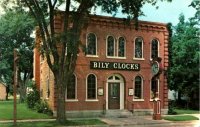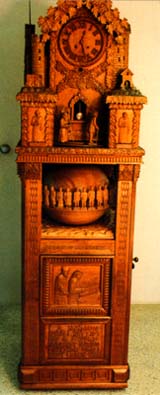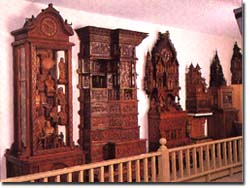
|
The Theater of Timeby Brian Peters
It's hard to remember how recently accurate timekeeping has become a given -- watches available for a pittance in almost any store, the 60 Minutes stopwatch becoming a charming antique even in the short time that show has been on the air. It's even harder to remember when clocks were things of springs and escapements and magic, and how much beauty that magic inspired.
The Bily brothers (it's pronounced bee-lee, slight accent on the first syllable) -- Joseph and Frank -- were born in Winneshiek County, Iowa, in the early 1880's. They were farmers by profession and woodcarvers by hobby throughout their working lives, apparently never traveling more than 34 miles from their farm. They were the sons of Bohemian immigrants, and lived with their parents, their older brother, and their younger sister on a 120 acre farm with a Ridgeway, Iowa, post office address. None of the children ever married or left home. Our slightly tardy start got us to our planned breakfast stop just a bit after eight. We were looking forward to this -- real food heaped on real plates, real silverware on real place mats, and a smiling server to set it all before us. A van with Alaska plates occupied by a disappointed looking family pulled out just as we were entering the parking lot -- seemingly the only vehicle there. Indeed, the sign on the door said they opened at nine. Instead we drove half a block to franchised fast-food: over-cooked egg and something vaguely meat like stuffed in a crumbling biscuit, wrapped in paper and served on a plastic tray to be eaten at a laminated plastic table and chairs, all bolted to the floor. I resisted claiming a moral victory. Spillville, where the clocks now reside, is usually reached from U.S. highway 52. If you think of Iowa as a vast, glacier formed rolling prairie, you'd be right for perhaps 85% of the state. But the far east, and especially the northeast part of the state, missed most of the glaciers, so much more of the terrain is limestone bluffs and deeply channeled waterways, with more than a few spectacular views of the Mississippi river. Highway 52 winds along the eastern border of Iowa through some of the best of this scenery, and our route included Millville and the descent into Garnavillo, which are arguably some of the most scenic highway miles in the state. My beloved brought a book. The Bily brothers had seemingly been practicing carpentry and wood-carving all of their lives, but didn't begin carving clocks until Frank was in his late twenties, and Joseph in his early thirties. Despite not being well-travelled, the brothers were not as isolated as you might suppose. Much the way the Internet can bring a slice of the whole world to anyplace with a phone connection, the postal service and catalogs and magazines brought the world to the Bilys. The earliest of their clocks are replete with intricate, lacy, scrollwork cuttings, and may have been made, at least in part, from patterns they acquired mail-order, and certainly relied primarily on wood ordered by catalog. All of us are creatures of our time and of the communities we join. The Bily clocks are all the more extraordinary when you consider the communities from which the Bilys drew inspiration. The most important of these is the American crafts movement. Only a pale remnant of this community remains, but in the Bilys' time it was a major force, linked by catalogs, and paper patterns, and magazines like Popular Mechanics. The movement has been ignored and mostly forgotten, because most of the products of the tens of thousands of crafters who followed the patterns and dreamed over the catalogs are largely -- forgettable. But from their very first design, the "Hall Clock," the Bilys transcended the patterns on which their clocks were based. Even with the brick-a-brack feel that remains in the pattern from the lace cut woodwork, there is an eye for upward line and overall effect that is entirely missing from the squat, over-decorated patterns on which it is based. We finished our drive to Spillville on state road 325, conspicuously labeled the "Dvorak Highway." My beloved, refreshed from her reading, was in a fine mood and prepared to flatter me by asking questions she probably already knew answers to. "So, why is it the Dvorak Highway?" "Because Antonin Dvorak, the Czech composer, spent a summer in Spillville, making a Thoreau-like pilgrimage to see rustic nature among immigrants from his homeland." "Seems a stretch as significant events go." "Yep." "What about the town, Spillville? Is there a falls or something?" "Well, the Turkey River runs through it, but it's actually named after a German, Joseph Spielman, and the original plat calls it 'Spielville.' Sometime after, the name was Anglicized, whether by Joe or by his Czech neighbors, it's hard to say." "And Winneshiek County?" "It's named after one of the chiefs of the Winnebago Indian tribe. They were resettled here for a time before pioneer settlers took over. The county seat town of Decorah is named after another chief." "They must have been popular." "After they were evicted, anyway."
In all likelihood, the brothers' limited education (which ended at the fourth grade), their lack of travel, their bachelorhood, and their shy natures trace, at least in part, to their roles in caring for and supporting their older brother. Perhaps the ascendent lines of their designs, and certainly the abundance of detail viewable at chair height, reflect an effort to delight John, imprisoned in a body unresponsive to his will. Certainly the intricate, toy-like nature of the clocks, chiming, and playing music boxes, and parading figures, had to be for the delight of John, who was in some sense forever a child. The brothers were a part of a social change as well. Introverted and untravelled as the brothers were, news of the clocks spread by word of mouth and by the occasional newspaper article until the traffic of tourists, in their newly purchased automobiles, overwhelmed the Bily house, and the clocks were moved to a farm shed near the house where their sister, Anna, began collecting admission -- ten cents a visitor. Newspaper accounts speak of 40,000 visitors a year trekking to the Bily farm to see the clocks. Anecdote has it that Henry Ford, assembling his museum of Americana at Dearborn, Michigan, offered the brothers a million dollars for the massive "American Pioneer History" clock, which they turned down. Certainly, they refused a considerable sum for temporary display of a portion of the clocks at the Chicago World's Fair.
Many of the clocks are now played on demand for the convenience of tours, but it isn't hard to imagine a past time when they performed at the appointed time only -- when a whole room full of clocks came alive on the hour, first for brother John, and then to the delight of queued visitors who'd traveled for miles on dusty roads to see them. The clocks have as many messages as they have carved panels, and moving figures, and chirping birds, but their universal appeal is as beautiful, mysterious toys. There's one clock that both of us loved more than any other, a smaller and mostly overlooked carving in the brothers' mature style, the "Struggle for Time" clock. It's a wall clock rather than a free-standing floor model, and the only motion is by the pendulum and clock hands. The light colored wood figures on the dark, curving case are frozen in their frenzied attempt to capture elusive time itself, reflecting the brothers' puzzlement at a world increasingly rushing, but always out of time. And therein lies both the irony and the beauty of the Bilys' theater of clocks, because for the brothers the clocks were toys to amuse, and not the tools to measure the regret of time wasted. In the end that may be the best reason to visit the Bily brothers museum of clocks -- to feel their vision of a world where time flows unrushed, and clocks delight. We'd spent a bit more time than we'd expected, entranced by the Bilys' creations, so we quickly abandoned our planned search for that just-so-right little ethnic restaurant and pounded down franchised entrees at the nearest cloned restaurant replica. Then we headed home, making those speed limits as aspirational as our aging car could manage, arriving home in a cloud of dust with a sigh. We were late, of course.
©2001 by Brian Peters Brian Peters lives precariously between a river and the great midwestern prairie on the low-rent side of a limestone bluff. |
| Home | Favorites | Links | Guidelines | About Us |
 We were planning a trip to see the Bily clocks, trying to leave on time, each in our separate ways. Eight o'clock was the agreed time. That's eight o'clock a.m. -- on a Sunday. I confess, I regarded the time as aspirational, like speed limits and stop signs and changing your oil every 3000 miles. Anytime before nine would be a moral victory, and I can go for days without a moral victory. I think that my beloved may have felt otherwise, perhaps even regarding 8:00 as the latest possible time that even marginally competent travelors could begin the the trip -- although I can't say absolutely for sure. I can say that we actually left at 7:25 a.m., and that we were late.
We were planning a trip to see the Bily clocks, trying to leave on time, each in our separate ways. Eight o'clock was the agreed time. That's eight o'clock a.m. -- on a Sunday. I confess, I regarded the time as aspirational, like speed limits and stop signs and changing your oil every 3000 miles. Anytime before nine would be a moral victory, and I can go for days without a moral victory. I think that my beloved may have felt otherwise, perhaps even regarding 8:00 as the latest possible time that even marginally competent travelors could begin the the trip -- although I can't say absolutely for sure. I can say that we actually left at 7:25 a.m., and that we were late.
 The Bily brothers made clocks -- or, strictly speaking, they made clock cases -- enormous, one-of-a-kind, hand-carved cases packed with clockworks, and music boxes, and moving figures, and a total effect, when the clocks were in motion, indistinguishable from magic. Then a thing happened to the Bilys that you read about only in books -- the world literally began appearing at their front door, begging to see them.
The Bily brothers made clocks -- or, strictly speaking, they made clock cases -- enormous, one-of-a-kind, hand-carved cases packed with clockworks, and music boxes, and moving figures, and a total effect, when the clocks were in motion, indistinguishable from magic. Then a thing happened to the Bilys that you read about only in books -- the world literally began appearing at their front door, begging to see them.
 The Bilys were hardly academics, and left very few records of their design process or the details of their lives, but there are some things which must have been significant. Perhaps the most obvious of these is their brother John Bily, a person afflicted with profound disabilities. John was born prior to the time when government or community played any role in caring for disabled adults. His lifetime care was primarily the full time job of his mother, Mary, but the brothers' lives were unquestionably shaped by his care and support. John was confined to a wheelchair, and apparently had limited powers of speech, yet such records and pictures as survive record a charming person of cheerful disposition.
The Bilys were hardly academics, and left very few records of their design process or the details of their lives, but there are some things which must have been significant. Perhaps the most obvious of these is their brother John Bily, a person afflicted with profound disabilities. John was born prior to the time when government or community played any role in caring for disabled adults. His lifetime care was primarily the full time job of his mother, Mary, but the brothers' lives were unquestionably shaped by his care and support. John was confined to a wheelchair, and apparently had limited powers of speech, yet such records and pictures as survive record a charming person of cheerful disposition.
 I confess that we arrived quite prepared to be disappointed by the clocks. Well, I did, anyway. The actual clock works, which were the part most likely to interest me, were standard manufactured assemblies, widely available by retail or catalog at the time the clocks were carved. That pretty much left -- clock cases. I'd seen the flat pictures of the display, and a couple of stock late-in-life photos of the brothers, and I'd mostly resigned myself that my beloved's good company and a rueful sense of humor about taking this trip would be the sum of the day's pleasures. I was quite wrong. The clocks in action have a sense of theater you have to be present to understand. They're housed in a large windowed room with a terrazzo floor, stone walls, and hard plaster ceiling, where the ticking of the running clocks echoes and rejoins until the whole room seems alive with clocks, each smugly clicking off the time until the scheduled magic begins.
I confess that we arrived quite prepared to be disappointed by the clocks. Well, I did, anyway. The actual clock works, which were the part most likely to interest me, were standard manufactured assemblies, widely available by retail or catalog at the time the clocks were carved. That pretty much left -- clock cases. I'd seen the flat pictures of the display, and a couple of stock late-in-life photos of the brothers, and I'd mostly resigned myself that my beloved's good company and a rueful sense of humor about taking this trip would be the sum of the day's pleasures. I was quite wrong. The clocks in action have a sense of theater you have to be present to understand. They're housed in a large windowed room with a terrazzo floor, stone walls, and hard plaster ceiling, where the ticking of the running clocks echoes and rejoins until the whole room seems alive with clocks, each smugly clicking off the time until the scheduled magic begins.